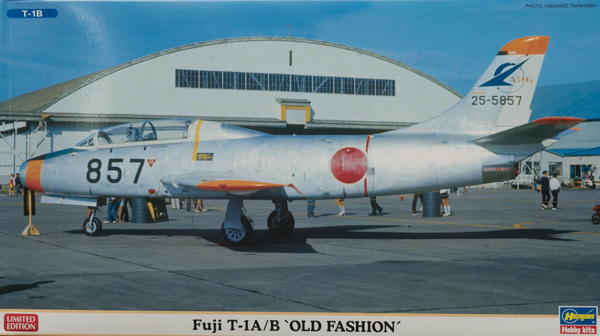
Hasegawa 1/72 Fuji T-1A/B "Old Fashion" Dual Combo
By Chris Banyai-Riepl
Overview
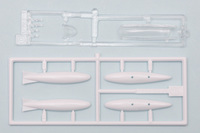 The Fuji T-1 was an indigenous trainer design that first took to the sky in 1958. Loosely based on the North American F-86, the Fuji T-1 was an excellent basic jet trainer, remaining the primary jet trainer for Japan for decades. The last Fuji T-1 was retired in March 2006.
The Fuji T-1 was an indigenous trainer design that first took to the sky in 1958. Loosely based on the North American F-86, the Fuji T-1 was an excellent basic jet trainer, remaining the primary jet trainer for Japan for decades. The last Fuji T-1 was retired in March 2006.
The Kit
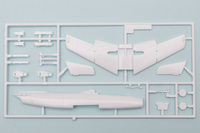 The Hasegawa kit of the Fuji T-1 is the only choice in 1/72, so although it's an older kit, it's still the best choice for those looking for a model of this Japanese trainer. This boxing provides two kits in the box, and the decal sheet is superb. Molded in white plastic, the kit features raised panel lines, a simple interior, and a fairly basic construction.
The Hasegawa kit of the Fuji T-1 is the only choice in 1/72, so although it's an older kit, it's still the best choice for those looking for a model of this Japanese trainer. This boxing provides two kits in the box, and the decal sheet is superb. Molded in white plastic, the kit features raised panel lines, a simple interior, and a fairly basic construction.
Diving into the construction, the instructions begin with the cockpit. This is made up from a flat base that gets a ring part to provide the side consoles. Separate seats, control columns, and instrument panels make up the rest of the interior, with the decal sheet providing the instrument panel details. This finished interior then fits into the fuselage halves, which have no sidewall detailing. All in all, this is a pretty simple interior, but the addition of seat belts and some basic side details will go a long way here.
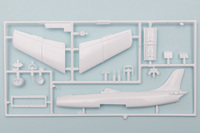 The nose intake is provided as a separate piece, as is the tailpipe. While the separate nose intake means that there is not much depth to those intakes, this is offset by the fact that it creates a space large enough in the forward fuselage to place weight. This kit will definitely need that, as there is a lot of weight behind the main wheels.
The nose intake is provided as a separate piece, as is the tailpipe. While the separate nose intake means that there is not much depth to those intakes, this is offset by the fact that it creates a space large enough in the forward fuselage to place weight. This kit will definitely need that, as there is a lot of weight behind the main wheels.
Moving to the wings, these are made up of a one-piece lower section and separate right and left upper halves. To reduce the need for filler, I would recommend attaching the lower wing piece first, and then the upper halves. The tailplanes are solid right and left pieces. For underneath the wings, there are two fuel tanks provided, with their separate pylons and braces. The landing gear is well detailed, with separate wheels and main strut retraction arms. Finally, the canopy comes in two pieces, and while it can be displayed open, given the basic interior I would recommend keeping it closed.
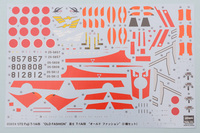 The decal sheet is what really makes this kit shine. The decals are almost as big as the box, and contain all the markings for all three options. This includes the big areas of orange found on one scheme, as well as a good selection of stenciling and other data markings. The first option is in overall silver, the second in overall white, and the third in white and orange. The decals are superbly printed and are definitely the highlight of this kit.
The decal sheet is what really makes this kit shine. The decals are almost as big as the box, and contain all the markings for all three options. This includes the big areas of orange found on one scheme, as well as a good selection of stenciling and other data markings. The first option is in overall silver, the second in overall white, and the third in white and orange. The decals are superbly printed and are definitely the highlight of this kit.
Conclusion
While an older Hasegawa kit, this is an interesting design that has had a long history in the JASDF. With the quality decal sheet and two kits in the box, this is a good way to add a pair of Fuji T-1s to your collection. My thanks to Hasegawa USA for the review sample.
